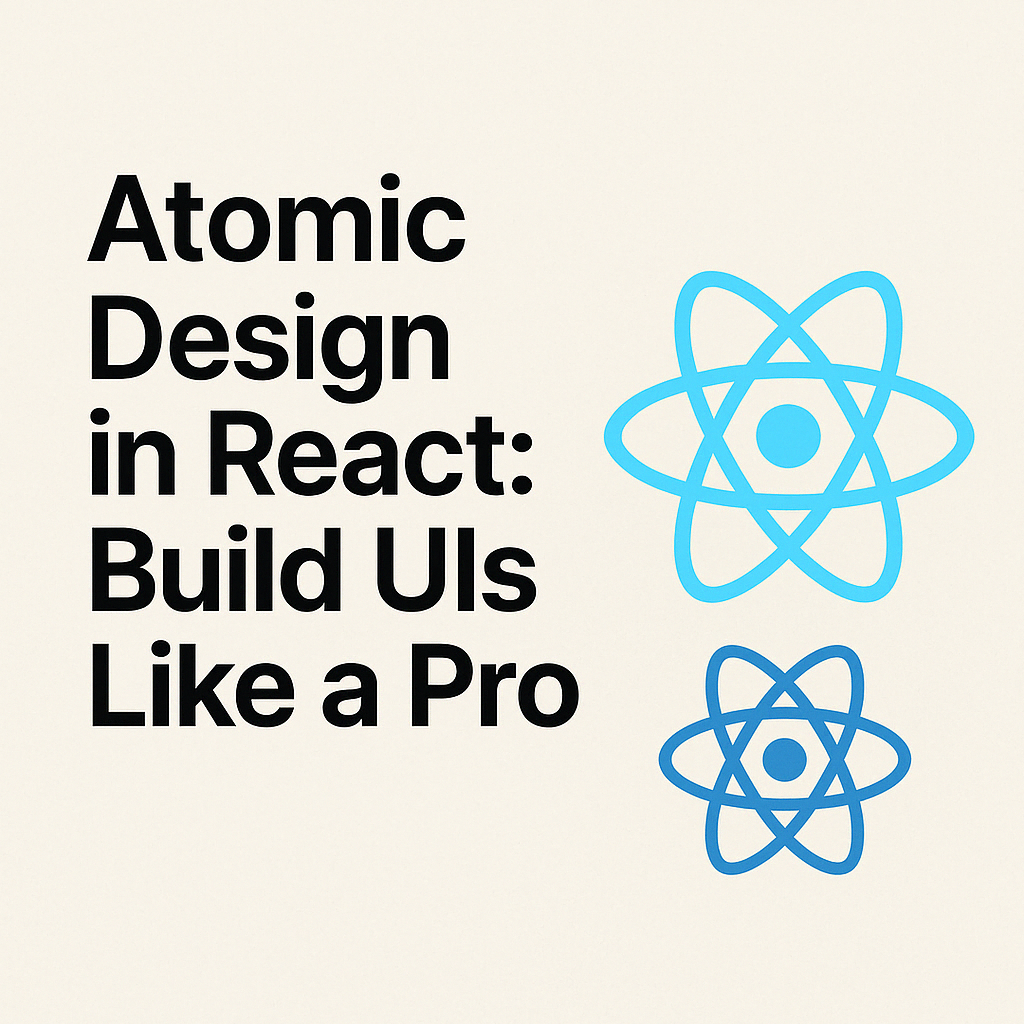Introduction
Atomic Design in React: Build UIs Like a Pro. In today’s fast-paced world of web development, consistency, scalability, and maintainability are key. As applications grow in complexity, developers often face challenges in managing UI components effectively. That’s where Atomic Design comes in — a methodology that helps you build design systems in a structured and reusable way.
Originally proposed by Brad Frost, Atomic Design divides UI components into five distinct levels: Atoms, Molecules, Organisms, Templates, and Pages. This system aligns beautifully with React’s component-based architecture, making it a powerful combination for modern UI development.
In this blog, we’ll break down Atomic Design in simple terms, show how it maps to React, and help you apply it to your next project like a pro.
Table of Contents
What is Atomic Design?
Atomic Design is a methodology for crafting design systems. It borrows concepts from chemistry, where all matter is composed of atoms. Here’s a quick breakdown of each level:
- Atoms: The smallest building blocks (e.g., buttons, inputs, labels).
- Molecules: Combinations of atoms functioning together (e.g., a search input with a button).
- Organisms: Relatively complex UI components made up of groups of molecules (e.g., a navbar).
- Templates: Page-level objects that place components into a layout.
- Pages: Specific instances of templates with real content.
Why Use Atomic Design in React?
React naturally encourages component-based development. Atomic Design helps structure those components for better reusability, scalability, and collaboration. Some benefits include:
- Clear separation of concerns
- Improved component reuse
- Easier team collaboration
- Scalable architecture for large applications
“Atomic Design gives you a methodology for thinking about your UI components, and React gives you the tools to build them.” — Brad Frost
Setting Up an Atomic Design Folder Structure in React
Here’s a sample folder structure that follows Atomic Design:
src/
components/
atoms/
Button.jsx
Input.jsx
molecules/
SearchBar.jsx
organisms/
Header.jsx
Footer.jsx
templates/
MainLayout.jsx
pages/
Home.jsx
This structure helps you find and manage components easily as your project grows.
Implementing Atomic Components in React
Let’s walk through a few examples to see Atomic Design in action.
1. Atom (Button.jsx)
const Button = ({ children, onClick }) => (
<button onClick={onClick}>{children}</button>
);
export default Button;
2. Molecule (SearchBar.jsx)
import Input from '../atoms/Input';
import Button from '../atoms/Button';
const SearchBar = () => (
<div>
<Input placeholder="Search..." />
<Button>Search</Button>
</div>
);
export default SearchBar;
3. Organism (Header.jsx)
import Logo from '../atoms/Logo';
import Navigation from '../molecules/Navigation';
const Header = () => (
<header>
<Logo />
<Navigation />
</header>
);
export default Header;
Best Practices for Atomic Design in React
- Keep components small and focused: Each component should do one thing well.
- Reuse atoms and molecules wherever possible.
- Use props to make components flexible and customizable.
- Document components using Storybook or similar tools.
Want to dive deeper? Check out Storybook for React — a great tool for developing and testing UI components in isolation.
Common Pitfalls to Avoid
- Overcomplicating the hierarchy: Not everything needs to be an atom.
- Premature optimization: Don’t worry about breaking down components too much from day one. Let the design evolve.
- Poor naming conventions: Stick to consistent and descriptive names.
When Not to Use Atomic Design
While Atomic Design works great for larger applications and design systems, it might feel like overkill for:
- Small projects or MVPs
- Rapid prototyping
In such cases, a simpler flat component structure might be more productive.
Tools That Work Well with Atomic Design
- Storybook – Visual component explorer
- Bit.dev – Component sharing platform
- Styleguidist – Style guide generator for React
Useful link: Bit.dev – Component Collaboration Platform
Conclusion
Atomic Design provides a structured methodology to build scalable and maintainable UIs. When paired with React, it becomes a powerful approach to create design systems that are modular, testable, and easy to work with.
Whether you’re building a design system for a large enterprise or just want to keep your codebase clean and reusable, adopting Atomic Design in your React workflow will definitely give you a professional edge.
So next time you start a React project, think in atoms, molecules, and organisms — and watch your UI come together like never before!
Find more React content at: https://allinsightlab.com/category/software-development

